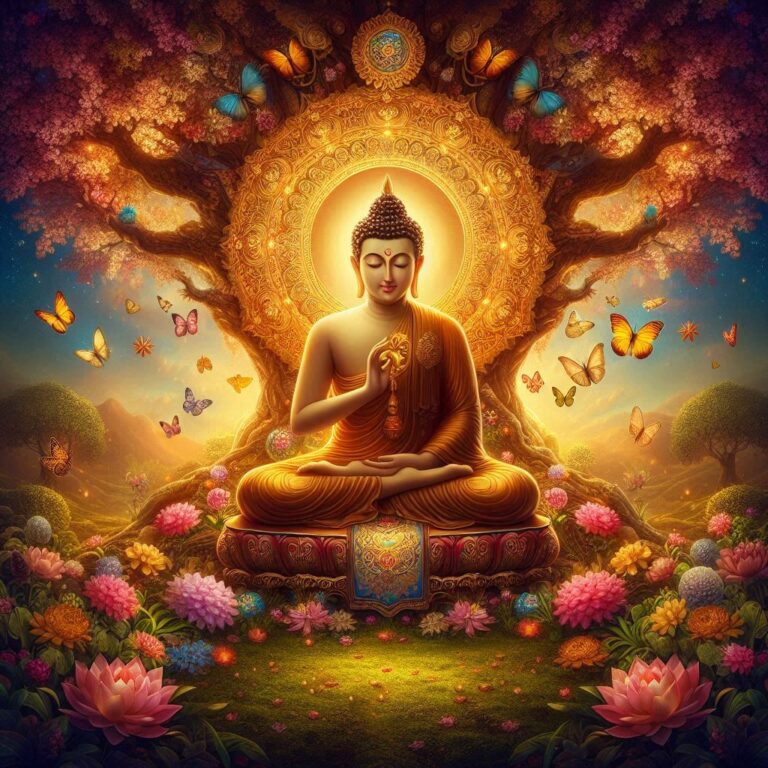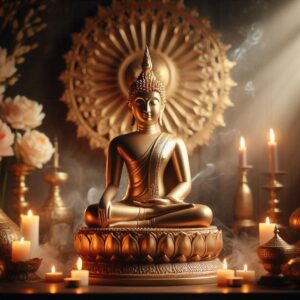🌼 Buddha Purnima 🌼
॥ ॐ श्री परमात्मने नमः ॥
🚩 Buddha Purnima 2024 🚩

History Of Buddha Purnima:
Gautama Buddha’s birth anniversary is commemorated on Buddha Purnima in Vaishakha month. Siddhartha Gautama, often known as Gautama Buddha, was a spiritual leader whose teachings laid the groundwork for Buddhism.
It is unknown when Gautama Buddha was born and when he passed away. But according to most historians, he lived from 563 to 483 B.C. The majority of people believe that Buddha was born in Lumbini, Nepal. Buddha passed away at Kushinagar, Uttar Pradesh, at the age of eighty.
Bodh Gaya is the most significant pilgrimage place for Buddhists that is associated with the life of Gautama Buddha. The three further significant pilgrimage sites are Sarnath, Lumbini, and Kushinagar. It is thought that Gautama Buddha first preached the Dharma at Sarnath, after gaining enlightenment at Bodhgaya.
On this day, according to legend, Gautama Buddha attained enlightenment. Buddha Jayanti, Vesak, Vaishaka, and Buddha’s Birthday are some other names for Buddha Purnima.
In North India, Lord Krishna is regarded as the eighth incarnation of Lord Vishnu, and Buddha as the ninth. But in South Indian belief, Buddha is never regarded as a Vishnu incarnation. In the southern region of India, Balarama is regarded as the eighth incarnation of Lord Vishnu, whereas Krishna is considered the ninth. Most Vaishnava movements consider Balarama to be an avatar of Vishnu. Buddha is not regarded by Buddhists as a manifestation of Lord Vishnu.
***
Buddha Purnima 2024 Date and Time:
2586th Birth Anniversary of Gautama Buddha
Buddha Purnima on Thursday, May 23, 2024
Purnima Tithi Begins – 06:47 PM on May 22, 2024
Purnima Tithi Ends – 07:22 PM on May 23, 2024
Rituals To Celebrate Buddha Purnima:

- People can visit the Buddha temple on the day of Buddha Purnima, present flowers, recite rhymes, and convey information about the life, teachings, and values of Gautam Buddha.
- Crowds of devotees flock to sacred temples such as the Mahabodhi Temple in Bodh Gaya, the Sarnath Temple in Varanasi, Dhaulagiri in Orissa, and several more. You are therefore welcome to visit these temples and seek blessings on this beautiful day.
- Kindness and nonviolence are among the standards and guidelines that any Buddhist taking part in the event must follow. They have to refrain from eating meat and wear white as a symbol of peace and compassion for the underprivileged.
- Devotees clean and adorn the Lord Buddha sculptures with fresh flowers and water. Devotees also give the less fortunate money, food, and clothing. In some parts of China and Southeast Asia, people also release caged birds or animals to mark auspicious occasions.
- On this auspicious day, people could make delicious delicacies like milk porridge or kheer and give them to loved ones who are less fortunate to spread joy and happiness.
- Many people also use this day to connect with the spiritual heart of Lord Buddha’s teachings through prayer and meditation.
***
Important Milestones in Early Buddhism:
- 563 B.C.: Prince Siddharta Gautama is born in Lumbini, Nepal. He later becomes known as Buddha, the founder of Buddhism.
- 528 B.C.: Buddha gains enlightenment while meditating under a Bodhi tree in Bodh Gaya, Bihar, India. This event is known as the “Awakening.”
- 483 B.C.: Buddha attains nirvana, the release from the cycle of rebirth, and passes away in a state of deep meditation.
- 269-231 B.C.: During the reign of King Ashoka, a patron of Buddhism, Buddhist evangelism begins and the religion spreads throughout Asia.
***
The Buddha’s Teachings:
- A day can be changed in an instant, and a life can be changed in a single day. And the world can change in the span of one life. The way to true happiness is to focus on the here and now rather than getting lost in the past or decorating your aspirations for the future.
- According to Lord Buddha, craving is the primary source of suffering. The destruction of craving is the first step toward freedom from the miseries and samsara chakra.
- He advised his disciples to “imbibe my knowledge and follow the path I have been told.” Regularly practice meditation.
- To break free from the circle of life and to end miseries, he advocated adopting the Ashtanga Marg. He highlighted Samyak vision, Samyak Sankalpa, Samyak Vyak, Samyak Karma, Samyak Aajeev, Samyak Karma, Samyak Smriti, and Samyak Samadhi about the Ashtanga Marg.
- The individual on the floor appears exhausted, and the night seems to go on forever, much like it does for many who struggle with insomnia. Likewise, the genuine road leads to an equally lengthy cycle of life and death for materialistic people.
- The ultimate religion, in Gautama Buddha’s opinion, is non-violence. The Yajna involved animal sacrifice, which Gautama Buddha opposed, favoring non-violence instead. Every living thing on earth has the right to live its life, according to Lord Buddha.
- The tongue kills without spilling blood, much like a sharp knife. Speak the truth in gentle tones at all times. Even among clever people, a foolish individual never tests the truth in his life.
- It would be better to conquer oneself than to win hundreds of battles. Then you will always have the victory. Neither a monster nor a god could take it from you.